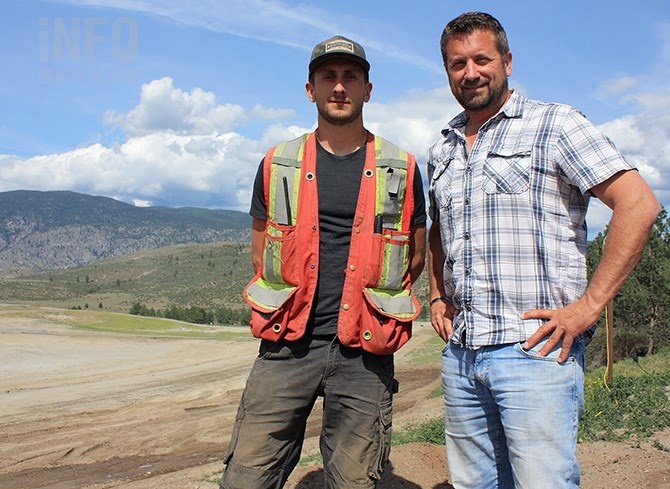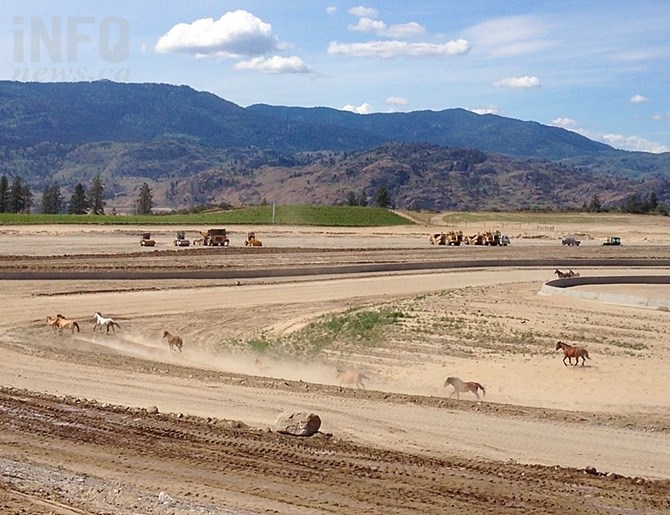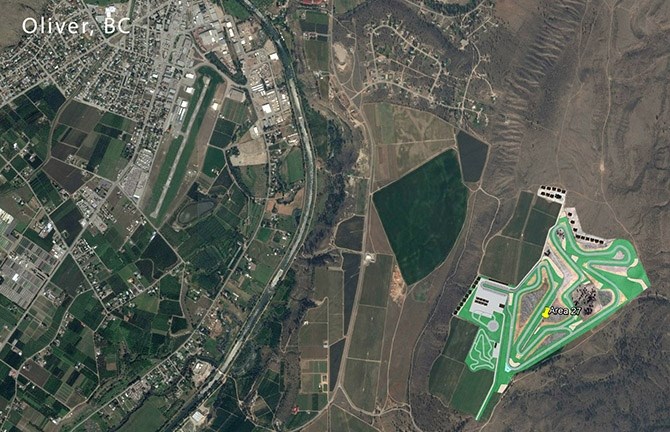
Area 27's contractors, Ryley and Trevor Seibert. The Formula One race track above Oliver is scheduled to have cars on the track by September.
(STEVE ARSTAD / iNFOnews.ca)
May 22, 2016 - 11:30 AM
OLIVER - The dream of having a Formula One race track in the South Okanagan is rapidly coming true on a mountainside bench just southeast of Oliver.
Area 27, which is described as a country club for driving enthusiasts, was founded by Bill Drossos, Jacques Villeneuve, Trevor Seibert and David King.
The project began in 2012 when Penticton resident Drossos saw a piece of land he thought would be ideal for a racetrack on his way back from a day of skiing at Mount Baldy.
He contacted the Osoyoos Indian Band and asked if they would entertain the idea of leasing some land for the track. The band expressed interest, and Drossos and Osoyoos band Chief Clarence Louie looked over several prospective properties, eventually abandoning Drossos’ initial choice in favour of the one currently being developed.
Trevor Seibert, who owns construction company Lake Excavating, is in charge of developing the site. He says the 4.85 kilometre track should have cars on it by September. He’s moved 350,000 cubic metres of earth to create the track, the outline of which is complete, and most of the earth moving is now finished.
“You don’t get the impression of how much earth has been moved,” he says, noting around the racers pit, eight metres of fill was needed to level the area off to make room for the pit and to provide room for car hauler’s parking.
Drossos and Seibert raced cars together 25 years ago. Seibert has been a pro racer since the 1980s, his son Ryley, who is helping manage the construction, also races and the two of them own a Canadian NASCAR team based out of Ottawa.
Their interest in racing is allowing them to take the Area 27 track to new levels of safety and innovation, as the two perform dual roles while constructing the track.
Jacques Villenueve and Seibert partnered on the design, which Seibert has been able to make improvements upon as construction takes place.
“To hire an engineer or track architect and then design something to give to a contractor who’s not a race car guy, that’s a different dynamic to be both,” Seibert says, pointing to a piece of the track where he and Ryley made a decision to place a wall based on their concerns as drivers for safety and best location, calling it a “field fit.”
“That’s more of a race car guy saying where should that wall go, so we won’t run into it,” he says.
“Once you decide what you want to do, you just go and do it. We have the equipment,” Seibert says, pointing to the numerous bulldozers, dump trucks and earth moving machines on the site.
Seibert says track construction has already provided a boost to the economy of the South Okanagan. About 80 per cent of the workers hired so far are members of the Osoyoos Indian Band.
"Once we’re operating there will be a need for vehicle storage, mechanical services and employment at the track,” Seibert says, adding investment in the track will be close to $20 million when the facility is completely built.
Seibert says Area 27 will likely operate for a minimum 10 months of the year, but if there is interest it could easily run year round. He says winter operations could include driving schools on a wet, cold track to teach winter driving strategies.

Area 27's track layout is pictured in this contributed photo.
Image Credit: Contributed
“I’ve driven on tracks all over North America, and this is the best one I’ve seen for spectator viewing. You can see almost 50 per cent of the track from most vantage points, and in few locations you can see almost all of it. That’s unheard of on other road courses like the Vancouver Indy. From a spectator standpoint, it’s excellent for that,” he says,
Area 27 consists of 227 acres under a 100 year lease. Siebert says there is a significant amount of land leftover to add other things, like a go kart and motorcycle track.
Seibert says Area 27 will operate much like a golf course, with members paying an initial lifetime membership fee and annual dues.
“The first 100 charter members got in for $30,000. It’s now up to $35,000 and once the track is paved it will rise to $45,000, with annual fees in the $3,500 range. As we add to the facilities, the cost of membership will rise,” Seibert says.
Casual racers will need to know a member to get on the track. Regular members can bring up to 15 guests per month, three guests per regular membership may drive one time per year, providing all driver eligibility requirements are met. Members will have 15 days a month to use the track, which could see five or 50 cars using the facility on any given day.
Guests who will be driving on the track will pay a daily use fee of $100, according to the Area 27 website.

Wild horses enjoy a run through the Area 27 property during construction. Once built the fences will go up and the only horsepower people will see at the track are the mechanical kind, under the hoods of members' race cars.
(STEVE ARSTAD / iNFOnews.ca)
The business plan for a members supported track was unique 20 years ago, but Seibert says it’s the “way things have gone” since.
“Hoping to get fans to pay for seats for a big event by building a track like this is a business plan that just doesn’t work anymore,” he says. “This plan is based on having 300 to 400 members paying a lifetime fee and annual dues, spreading the risk so you don’t have to fill grandstands.”
Siebert expects there will be spectator events at the track, which will be the second largest in Canada, bigger than Mosport in Toronto, and the largest track west of Ontario.
“We aren’t building it for events, but we’ll have some. Having to worry about selling a ticket isn’t our business model."
"Potentially NASCAR Indy could run here, and everything up to that level, but the gist of it is a country club atmosphere. It’s not a race environment, it’s more of a performance thing where one can learn to drive, once checked out to handle the track, and have some fun without having to worry about a cop in the rear view mirror,” Seibert says.
Seibert says the track could also see use by schools teaching driving safety or manufacturers showing off their products.
The group will likely tap into the market south of the border, noting with the dollar exchange, Area 27 represents a good deal for American motorsport enthusiasts.
He stresses members won’t be faced with a competitive racing environment they may not be prepared for.
“It’s not a race, it’s a place to bring your car, drive at your own speed and not have to worry about the speed limit. There will be some competitive club events and people can graduate up in skill level.
You don’t have to be a race car driver. It’s just like a golf club, a place you can come and hang out after work, drive a few laps, and have some fun,” Seibert says.

Area 27 is located near Oliver, B.C.
Image Credit: Contributed
To contact a reporter for this story, email Steve Arstad or call 250-488-3065 or email the editor. You can also submit photos, videos or news tips to the newsroom and be entered to win a monthly prize draw.
We welcome your comments and opinions on our stories but play nice. We won't censor or delete comments unless they contain off-topic statements or links, unnecessary vulgarity, false facts, spam or obviously fake profiles. If you have any concerns about what you see in comments, email the editor in the link above.
News from © iNFOnews, 2016